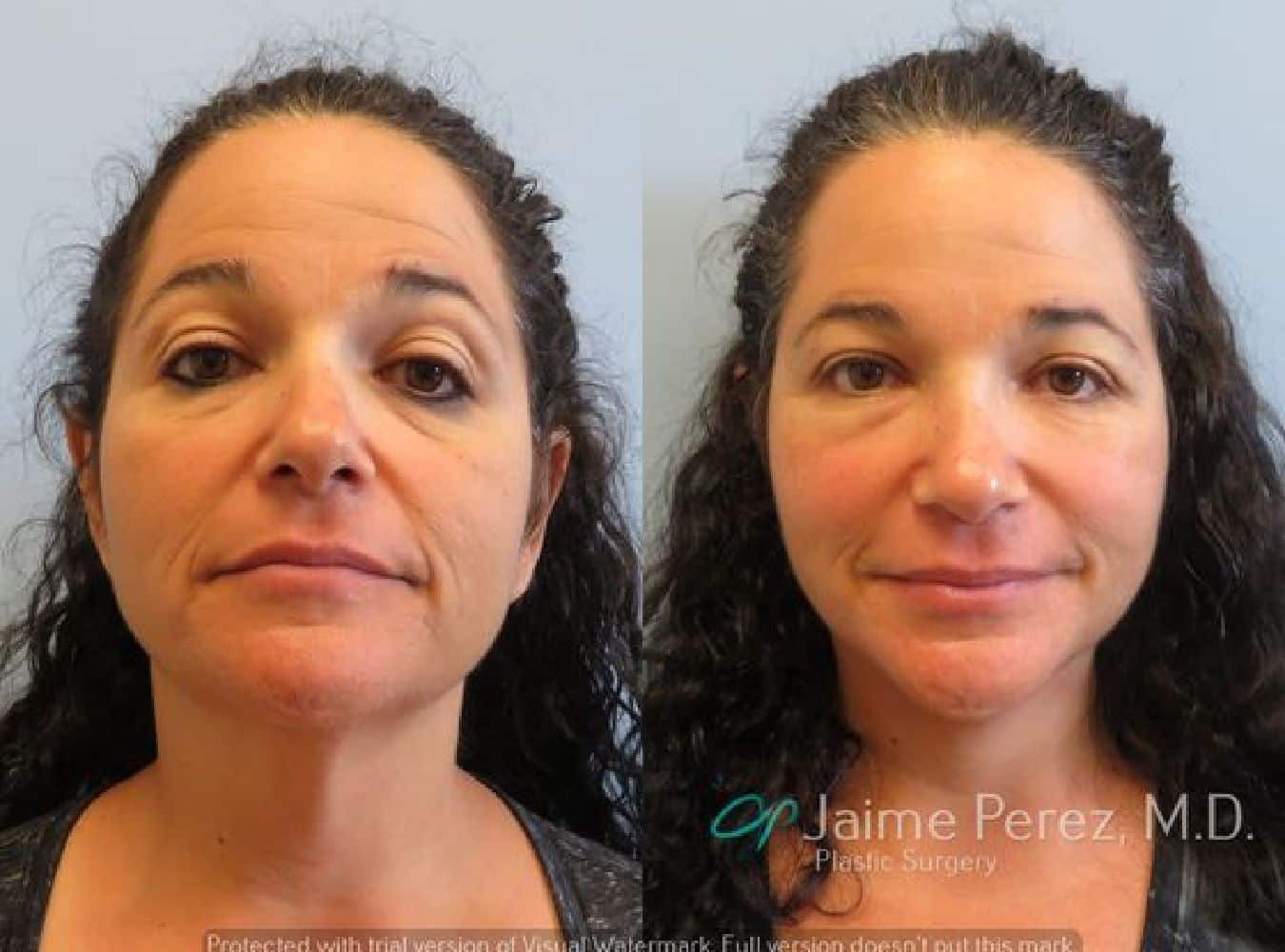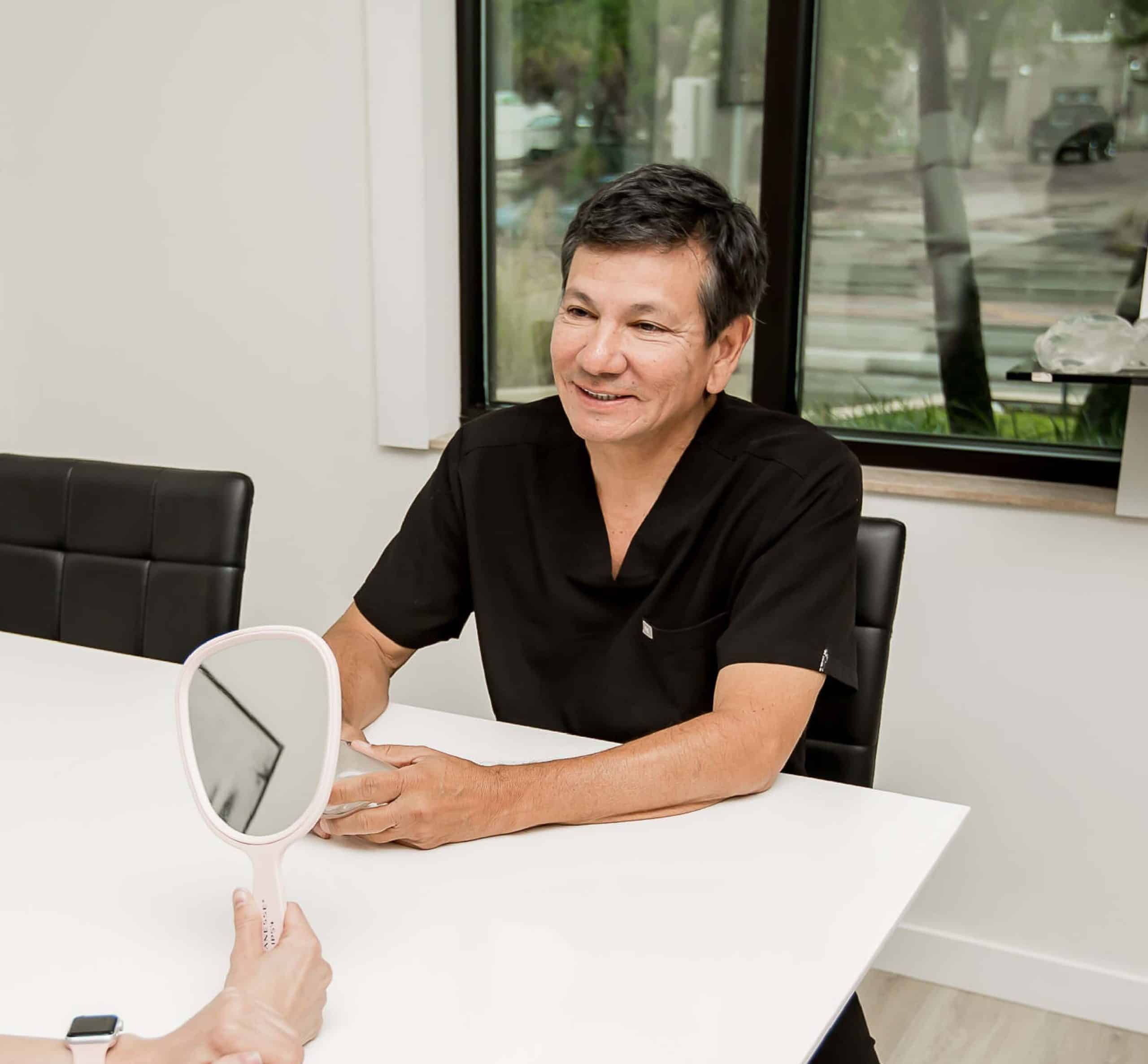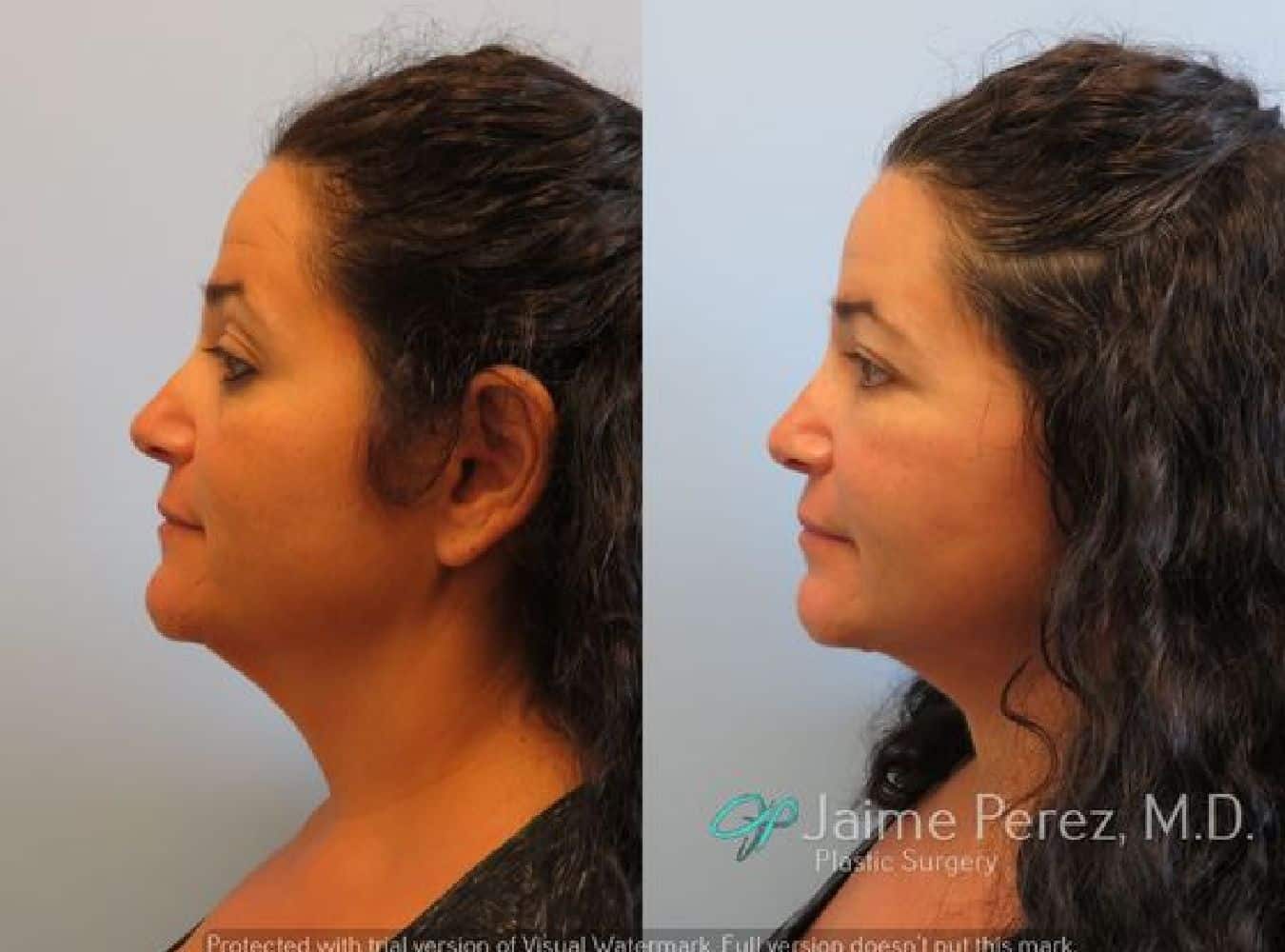Facelift (Rhytidectomy) in Tampa, FL
Contact Model
Model
As you age, it is common, and often surprising and frustrating, to notice new lines where you previously had none.
You may no longer have the long, elegant neck you had in your twenties and thirties. Your jaw line may have started to look a little saggy and your cheeks may appear to have fallen. While the aging process is unavoidable, there is something you can do about it, and no one ever has to know (if you don’t want them to)! You can’t stop the passage of time; however, Dr. Jaime Perez at the Plastic Surgery Center of Tampa can reverse the clock and help slow it down.
Whether you are in your forties and want a “maintenance lift” to retain a youthful appearance, are interested in a short-scar endoscopic facelift, have already had a facelift and need a revision, or are not sure what you need, Dr. Perez’s delicate and innovative facelift techniques will leave you looking refreshed and youthful for years to come. Your face is the first thing people see; trust it to the best, trust it to Dr. Jaime Perez.
 Actual Patient
Actual Patient
Facelift
 Model
Model
Facial Aging
The process of facial aging is multifactorial; it is not simply the cumulative effects of gravity on the face over a number of years nor is it directly proportional to chronological age. Facial aging is dependent on individual genetics and inherited features, lifetime sun exposure, overall health, a history of weight gain or loss, and many other factors. Additionally, the various tissues of the face show signs of age in different ways. The bones of the face lose volume over time because of osteoporosis. Facial fat decreases in volume in some areas (e.g. temples), increases in others (e.g. above the eyes, under the chin), and changes position (e.g. under eye bags), all of which contribute to the look of an aged face. The muscles of the face also decrease in volume and lose tone contributing to bags around the eyes, folds around the mouth and chin, and a sagging neck line. The skin of the face experiences a loss of thickness, clarity, and elasticity contributing to the appearance of wrinkles, folds, and a dull complexion.
The tell-tale signs of facial aging are wrinkles and folds. Static wrinkles (i.e. wrinkles that are present even when the skin is not being moved) are due to textural changes in the skin secondary to sun damage and the aging process in general. These wrinkles cause “crinkly” skin often seen on the cheeks, backs of hands, and chest. These wrinkles can often be effectively treated with facial peels and good skin care. Mimetic wrinkles (i.e. wrinkles present when the underlying muscles and skin is moved) are deeper creases caused by repeated facial movement and are perpendicular to the underlying facial muscle. Good examples of mimetic wrinkles are found on the forehead, around the eyes (i.e. crows feet), and around the lips.

Treatments for Facial Aging
These wrinkles are best treated with a combination of Botox® Cosmetic, dermal fillers, and surgery. Folds, on the other hand, are a result of overlapping skin, fat, and muscle caused by genetics, muscle and skin laxity, and a loss of fatty and bony volume. Folds are most commonly seen surrounding the nose and upper lip (i.e. nasolabial folds), around the chin (i.e. marionette lines), above and below the eyes (i.e. puffy eyelids or bags under the eyes), and down the neck (i.e. platysmal bands). Folds can usually only be effectively treated by surgery that tightens and repositions all soft tissues of the face including skin, fat, and muscle.
History of Facelift Surgery
Plastic surgeons have been performing facelifts since the early 1900s. Due to a lack of understanding of the intricacy of facial aging, traditional facelifts were generally designed to only tighten the skin of the face and did not address muscle laxity or malposition of facial fat. This often resulted in an unnatural “pulled” appearance and required early revisions. Throughout the years, facelift techniques have been refined to address the underlying causes of facial aging, specifically muscle laxity and fat malposition. Today’s facelift techniques are aimed at restoring facial tissues to their original position while utilizing smaller and smaller incisions with less down time. Dr. Perez is one of Florida’s leaders in short scar and endoscopic facelift techniques that today’s patients demand.
Facelift in Tampa – by Dr. Jaime Perez
Facelift, or rhytidectomy, is the term given to a wide variety of procedures used to surgically rejuvenate the face by tightening the skin and sometimes underlying muscles and fat of the face. A facelift best addresses the signs of aging in the lower face, including the lower cheeks, jaw, and upper neck. The forehead, brows, and upper eyelids are best treated with a brow/forehead lift while the mid face and lower eyelids are best addressed with a mid facelift and/or lower eyelid surgery. These and other procedures are often performed in combination to provide a full, harmonious, youthful appearance. Depending on the individual, various well-hidden incisions, levels of dissection, and surgical techniques are used.
Because the process of facial aging is so complex and varies patient to patient, a plastic surgeon must first understand the aging process and be skilled at diagnosing the underlying causes of an aged appearance. Second, the surgeon must be able to communicate with patients and understand their goals for surgery. Thirdly, the best plastic surgeons must be skilled technicians and have a full array of surgical procedures with which to soften the signs of aging.
Dr. Perez has trained with some of the most well-respected facelift surgeons in New York and New Jersey; not only did he learn what those great masters had to offer, but he has continued to refine his techniques over ten years in private practice. He is not limited to a single routine operation that he offers to all patients. After careful evaluation and consideration he tailors each surgical plan to fit every individual patient’s needs and is able to provide long-lasting, natural appearing facelifts.
Ideal Candidate for Facelift Surgery
Patients interested in facelift surgery are usually displeased with the appearance of their face as they have gotten older. Patients often complain of deepening of grooves or folds between the nose and upper lip (i.e. nasolabial folds), lines between the lower lip and chin (marionette lines), and a sagging jaw line or jowls.
Ideal patients are healthy, have medical problems like high blood pressure or diabetes under control, have no history of bleeding or clotting disorders, do not smoke, and are at a stable weight.
Facelift Surgery Considerations
Like all surgeries, there are certain known risks associated with facelift surgery. The most common complication observed in facelift patients throughout the United States are blood collections under the skin or muscle-fascia layer that require surgical drainage. This occurs in one to two percent of patients but is more common in males and patients with a history of high blood pressure, chronic coughing, or postoperative nausea. Thus, prior to any facelift surgery, all patients must have high blood pressure and/or chronic cough under control. Additionally, anti-nausea and blood pressure medications are usually given preoperatively to reduce the risk of postoperative nausea and dramatic changes in blood pressure.
Other less common complications encountered in facelift surgery patients is injury to the nerve that supplies the facial muscles or provides sensation to the face. These injuries occur in less than one percent of patients. When nerve injuries occur, the loss of facial movement or sensation usually returns in three to six months. It is also possible to encounter widened or irregular scars, wound healing problems, and infection, but this is exceedingly rare. Dr. Perez sees all of his facelift patients the day after surgery so that in the unlikely event there is a complication, it can be dealt with in a timely and efficient manner.
We Offer Virtual Consultations for Your Convenience
Dr. Perez is proud to offer virtual consultations so you can discuss your cosmetic goals and learn about treatment options from the comfort of your home.
 Model
Model
Postoperative Care – Facelift Surgery
Facelift surgery is usually performed under general anesthesia in an outpatient surgery center, meaning the patient goes home the same day. The surgery itself takes three to four hours, depending on technique. Patients go home with a big, bulky dressing and possibly a drain; all patients are examined the day after surgery and if a drain was placed, it is likely removed at this time. Most patients experience a significant amount of bruising and swelling after the surgery; however, this begins to decrease after one week to ten days and is usually down to a socially acceptable level by three weeks.
Surgical Technique of Facelift
A face lift is usually performed under general or local anesthesia on an outpatient basis, meaning the patient goes home the say day. Rarely, if a patient has other procedures performed in addition to a face lift, an overnight stay may be required. The surgery usually takes three to four hours depending on the individual technique that Dr. Perez feels is most appropriate. Occasionally, if only a mini-lift or small revision is needed, this can be performed under local anesthesia in Dr. Perez’s new, state-of-the art office, the Plastic Surgery Center of Tampa.
“Jaime Perez is one of the best and few Board Certified Plastic Surgeons in Tampa.” – GR
The various types of face lifts can generally be divided into superficial and deeper plane procedures depending on the exact level of dissection. The levels, or planes, of the face from the surface (i.e. superficial) to deep are skin, fat, muscle-fascia layer (i.e. SMAS), and bone. Superficial plane face lifts involve dissection under the skin but above the muscle-fascia layer. Deeper plane face lifts involve dissection deep to the muscle-fascia layer. Each type of face lift has pros and cons and not one type of face lift is suitable for all patients in all instances.
Subcutaneous (Skin Only) Face Lift
A subcutaneous, or skin only, face lift is one in which dissection is limited to the fatty plane between the skin and underlying muscle-fascia layer. An inconspicuous incision is made along the sideburn, in front of the ear, under the ear lobe, ending in the hairline near the nape of the neck. With the technique, the skin and various amounts of fat, depending on technique, can be excised and redraped to reduce facial wrinkling, soften the appearance of nasolabial folds, decrease jowling, and better define the neck. Incisions are meticulously closed with a no-tension technique to ensure barely visible scarring. Ideal candidates for a skin only face lift have moderate amounts of lax skin, minimal to moderate amounts of facial fat, and little to no muscle-fascia malposition. Proponents of this technique note ease of dissection, decreased risk of nerve injury, and a shorter recovery time. Critics of this technique claim that deeper plane face lifts provide a more dramatic, powerful, longer lasting result.
Mini-Face Lift
A mini-face lift is actually not a face lift at all, but rather a limited, skin tightening procedure. With a mini-face lift, an elliptical incision is made in front of the ear and a small wedge of skin is excised to produce a limited tightening of the lower cheeks. This procedure is primarily performed as a secondary surgery after a complete face lift in patients who have a recurrence of nasolabial folds or sagging soon after their original operation. In rare cases, younger patients who have only a minimal amount of sagging of the lower cheeks may be candidates for this procedure as well. The benefits of this surgery are obvious and include limited dissection with minimal downtime; however, the results are also minimal and almost never effective as a primary facelifting procedure.
Subcutaneous (Skin Only) Face Lift with Muscle-Fascia (SMAS) Tightening
A skin only face lift with muscle-fascia (SMAS) tightening is similar to a traditional skin only face lift; however, the underlying muscle-fascia layer is tightened with sutures, excised, or a combination of both to aid in reshaping the facial soft tissues. The SMAS can be plicated (i.e. tightened with sutures), imbricated (i.e. cut, redraped, and tightened with sutures), or excised (i.e. partially removed with the remaining SMAS tightened with sutures). Incisions and closure techniques are similar to the traditional skin only face lift. Ideal candidates for this procedure have moderate amounts of skin laxity, minimal to moderate amounts of facial fat, and little muscle-fascia malposition. Supporters of this technique claim that suturing the muscle-fascia layer allows for better definition of the jaw and neck while having less risk of nerve damage or other complications associated with deeper plane face lifts. Skeptics note minimal results obtained by suturing the muscle-fascia layer without dissecting it free of underlying attachments. It is also reported that suturing the newly positioned muscle-fascia layer can be unreliable leading to early recurrence of an aged appearance and need for early revision.
Sub-SMAS Face Lift
A sub-SMAS, or sub-muscle-fascia face lift, involves dissection above and below the muscle-fascia layer of the face. The increased amount of dissection allows for movement of the skin and underlying muscle-fascia layer in different directions permitting greater tightening of muscle-fascia layer, less tension of the skin closure, and longer-lasting, natural results. An inconspicuous incision is made along the sideburn, in front of the ear, under the ear lobe, ending in the hairline near the nape of the neck. Various amount of skin are excised and redraped to reduce facial wrinkling, soften the appearance of nasolabial folds, decrease jowling, and better define the neck. The muscle fascia-layer is dissected free of the underlying tissues and tightened to further reduce nasolabial folds and jowling and better define the jaw line. Incisions are meticulously closed with a no-tension technique to ensure barely visible scarring. Ideal candidates for a sub-SMAS face lift have moderate amounts of lax skin, moderate amounts of facial fat, and moderate amounts of muscle-fascia malposition. Proponents of this technique claim that the sub-SMAS dissection provides more dramatic, longer lasting results than a standard skin-only face lift. Critics of this technique feel that the greater amount of dissection poses an increased risk of facial nerve injury, more postoperative edema, and a longer recovery time.
Deep Plane Face Lift
A deep plane face lift is similar to a sub-SMAS face lift with dissection beneath the muscle-fascia layer, however, only limited dissection is performed above the muscle-fascia layer. Proponents claim that the minimal dissection between the skin, fat, and muscle-fascia layer gives the skin an even smoother appearance and faster recovery time while still providing dramatic, longer lasting results than with a standard skin-only face lift.
Composite Face Lift
A composite face lift is essentially a deep plane face lift that includes dissection and tightening of the muscles beneath the lower eyes. Proponents claim that tightening of the muscles around the eye rejuvenates the upper face and reduces the appearance of bags under the eyes. It is felt that this added step results in a more harmonious, youthful appearance of the entire face rather than just the mid and lower face.
Subperiosteal Endoscopic Face Lift
A subperiosteal face lift involves dissection in the plane of tissue just above the facial bones, below the skin, fat, and muscle-fascia layer of the face. Depending on technique, varying amounts of dissection just beneath the fascia-muscle layer are also performed. Incisions are usually made just under the lower eyelid eyelashes or inside the mouth; a second incision is usually made in front of the ear and an endoscope is used to complete the subperiosteal dissection. Ideal patients are generally younger and require less skin excision than a traditional face lift patient, have bags under the lower eyes, and minimal to moderate nasolabial folds. Supporters of this technique feel that greater rejuvenation of the upper and mid face can be achieved with a subperiosteal face lift than with traditional skin only or sub-SMAS face lifts. Additionally, it is felt that the results of this face lift last longer and produce a more natural result. The added use of an endoscope makes for safe dissection through smaller scars. Critics of this technique note an increase in facial nerve injury and often inadequate correction of nasolabial folds and jowls.
 Model
Model
Contact us online or call Dr. Perez
(813) 877-3739Combining exceptional surgical skills and an eye for beauty, Dr. Jaime Perez strives to enhance the natural features of his patients. When you trust your cosmetic needs to a dedicated and experienced plastic surgeon like Dr. Perez, you can feel confident that you will enjoy the highest standard of care and the most natural-looking and long-lasting results.
Schedule A Consultation
Patient Testimonials
Thank you so much for the amazing job you have done!! I am so happy with my results! You truly have been given the special gift and use that to make people feel beautiful, physically and mentally!! Again thank you so much!!
Amanda
Thank you for taking such good care of me. I have been to many plastic surgeons in the past and I know you guys are the best! God works in mysterious ways and I was blessed to find you. I truly don’t believe anyone else could have done this. THANK YOU!
Brandi
I was very impressed and satisfied with my procedure and how well I was treated. The entire staff always has a smile on their face and a kind word. Dr. Jaime Perez has a bedside manner that evokes confidence and appreciation in his abilities
Milan

Start Your Transformation Today
Tampa Office
307 S MacDill Ave.
Tampa, FL 33609

